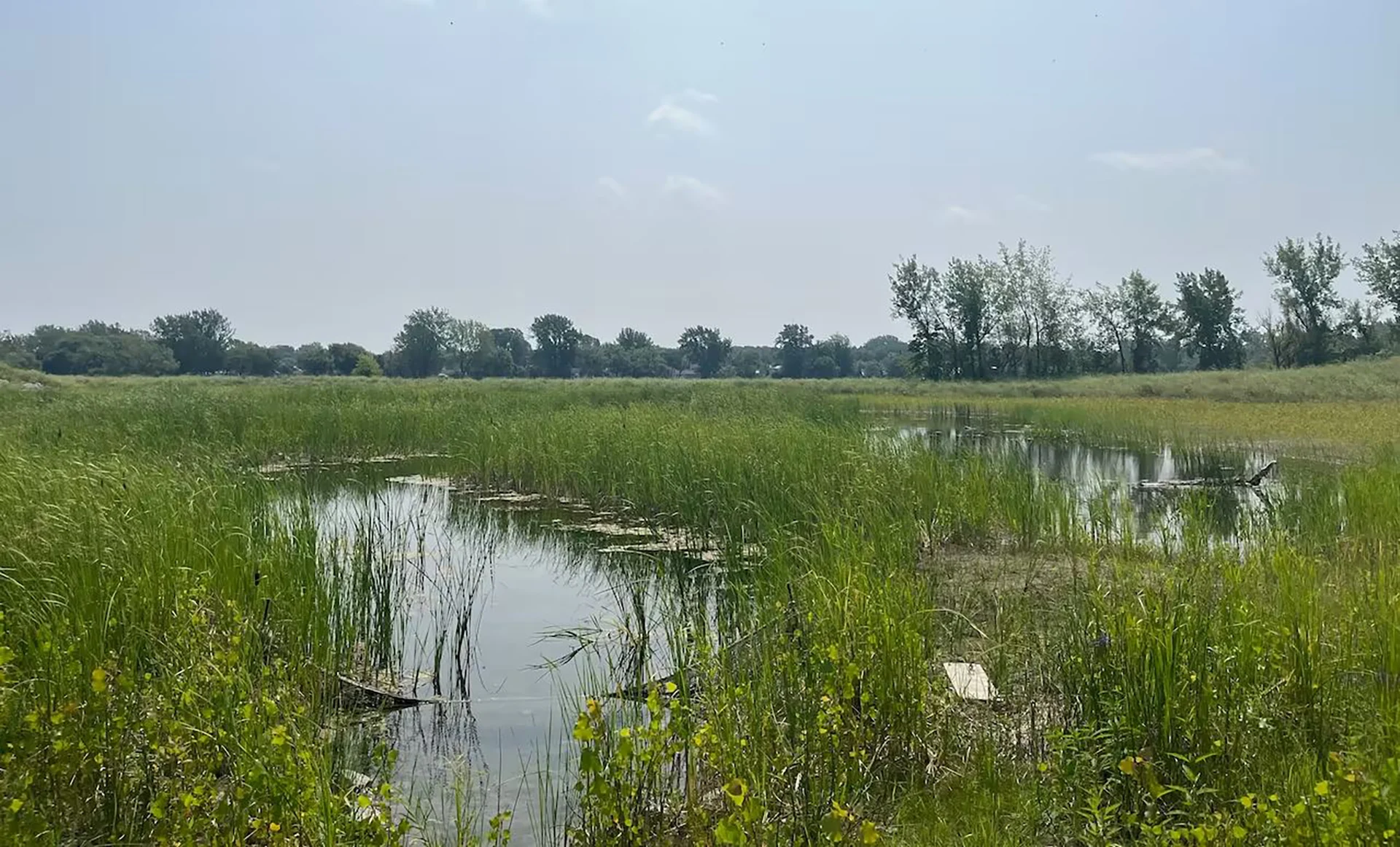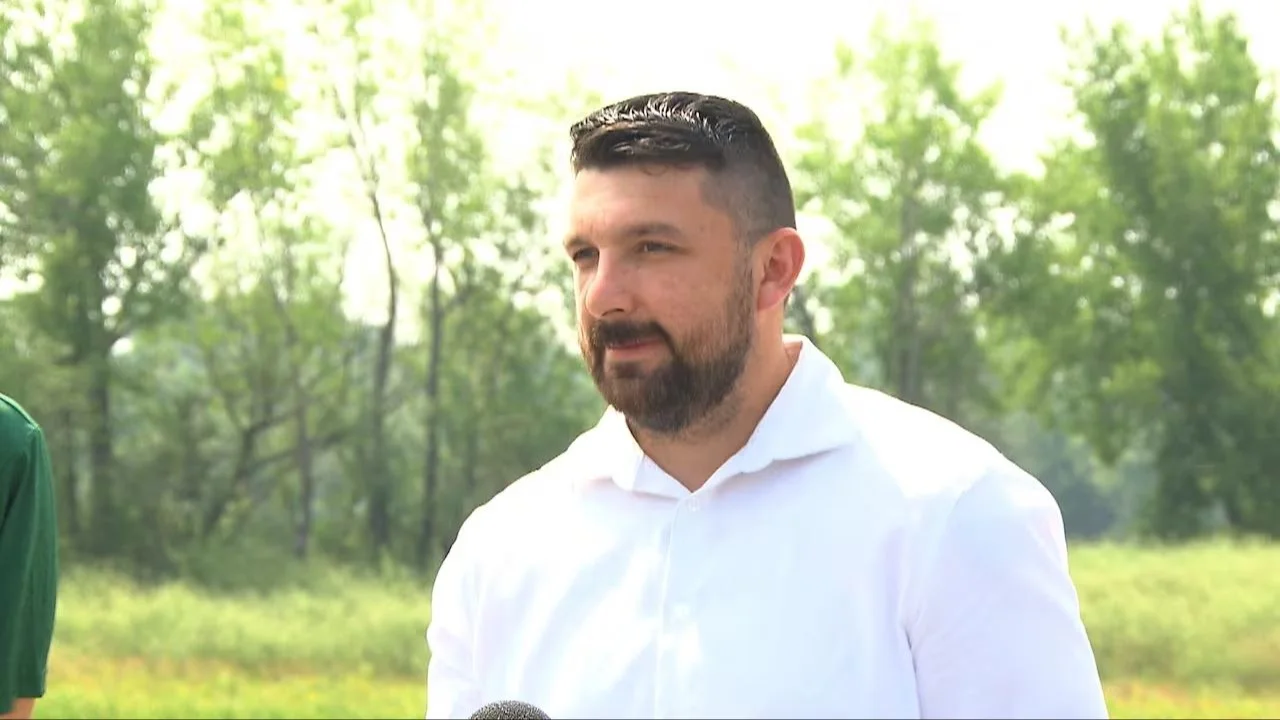
Kahnawà:ke's bay restoration hailed as an example of Indigenous-led conservation
When Cody Diabo recently learned that the bay restoration project on Kateri Tekakwitha Island was near complete, he took his family for a walk there to see its transformation from a dry, rocky shore into a marsh teeming with life.
The island off of Kahnawà:ke, a Kanien'kéha community south of Montreal, was once a small archipelago of lush, natural islands — but it became a single piece of land after sludge from the river was dumped onto the archipelago by construction crews building the St. Lawrence Seaway about 70 years ago.
"For the first time coming to the island since I was a little child, I saw corn growing," Diabo, council chief responsible for the environment portfolio at the Mohawk Council of Kahnawà:ke, said at a news conference Wednesday announcing the completion of the nearly decade-long project to restore water flow in the bay and naturalize its surroundings.
"To be able to see a substance that's dear to Onkwehonwe people and Kanien'kéha people — corn — growing here, where it was essentially barren for a while … that was just a sign that we were doing something really good."

Cody Diabo, council chief responsible for the environment portfolio at the Mohawk Council of Kahnawà:ke, says he saw corn growing on Kateri Tekakwitha Island for the first time recently, a sign of the island's newfound biodiversity. (CBC)
For decades, the island was rocky and arid, save for towering grey poplars and sumac trees peppered throughout it.
Now the bay, situated midway through the island, is a peaceful oasis complete with a protected nesting area for turtles and a habitat for the at-risk bank swallows migrating through the area.
READ MORE: Power to the People: A path forward out of the climate crisis
More than 15 years ago, the Kahnawà:ke Environment Protection Office (KEPO) began studying why the bay was filling with sediment and getting choked by weeds so thick that boating, swimming and fishing were nearly impossible in the small area that still ties the community to the St. Lawrence River.
The seaway, inaugurated by Canada and the United States in 1959, cut off Kahnawà:ke's access to the river, replacing the natural waterway with a narrow canal for large cargo ships to bypass the rapids after which the community is named — and took with it an entire way of life. In all, the federal government expropriated 1,262 acres of Kahnawà:ke's land for the massive industrial project.
'Land expropriation at its worst'
Once KEPO realized the sediment buildup was caused by the seaway and agricultural runoff from the Châteauguay River, it undertook modelling to figure out how to increase water flow and invited community members to weigh in on solutions.
A section of the bay was dredged to make it deeper and the Seaway Management Corporation agreed to increase flow by slightly opening its locks. Sediment had piled so high the water was only about 60 centimetres deep, according to Vladimir Koutitonsky, a physical oceanographer who worked on the modelling.
"It was sad to see what had been done without thinking of the consequences for the community," Koutitonsky said.
KEPO cobbled together funding, mostly from the federal government but also from other sources, such as CDPQ Infra, a subsidiary of Quebec's pension fund manager the Caisse de dépôt et placement du Québec, which is responsible for the Réseau express métropolitain (REM) light rail project launching next week.

Benjamin Green-Stacey says Kahnawà:ke's bay restoration is an example of the success of Indigenous-led land stewardship. (Verity Stevenson/CBC)
The office was eventually able to purchase a boat designed to harvest aquatic plants so that it could pull up the weeds that had infested the bay, also helping to increase water flow and making the water easier to enjoy. It also created a beach on the islands eastern tip, at the request of community members who wanted to be able to swim in the water as their elders had as children.
Benjamin Green-Stacey, KEPO's new director, says the construction of the seaway was one of the most traumatic events that Kahnawà:ke had experienced as a collective.
"This is the result of environmental racism. This is land expropriation at its worst," Green-Stacey said. "There's this whole generation now that's grown up without access to the river and we'll never experience what it was like to have direct river access.
"And so to see it transformed into a more naturalized space… that can help us get back to appreciating our relationship and interconnectedness with nature and with this space, with our place, it's profound."
Cole Delisle, the environmental projects co-ordinator for terrestrial habitats, said he was struck by the deafening sound of frogs singing one early morning this spring when he visited the bay for some field work.
'To really see our medicines coming back'
Diabo, too, remarked on the cacophony of nature sounds the bay now produces.
"Hearing the birds, hearing the insects and just being able to see visually how beautiful it is, this is a good day," he said.

The St. Lawrence Seaway is seen on the other side of Kateri Tekakwitha Island in Kahnawà:ke. The seaway was created for large cargo ships to bypass the rapids in St. Lawrence River after which the Kanien'kéha community south of Montreal was named. (Verity Stevenson/CBC)
Lynn Jacobs, the former director of KEPO, said she's already noticed how many more species have returned to the area, including bank swallows flying over the marsh "by the hundreds."
"To really see our medicines coming back … it's example of what environmental stewardship can do," Jacobs said.
Patrick Ragaz, KEPO's general manager of field science, who has been working on the restoration project for eight years, said some 100 pairs of bank swallows filled their new habitat just two weeks after it was built.
Green-Stacey says the project is an example of how successful community-driven, Indigenous-led land stewardship can be in restoring biodiversity. In December, Prime Minister Justin Trudeau announced the federal government would invest $800 million over seven years on four Indigenous-led conservation initiatives.
The KEPO director says he hopes awareness of the importance of biodiversity, aided recently by the COP15 conference held in Montreal, and reconciliation efforts in Canada will make it easier for these kinds of initiatives to get funding.

Tyler Moulton, left, Cole Delisle, middle, and Carlee Kawinehta Loft, right, all work for the Kahnawà:ke Environment Protection Office (KEPO), which led the bay restoration project. (Verity Stevenson/CBC)
While the restoration itself is completed, KEPO staff have a plan to monitor the bay and continue work on improving water flow for the next 10 years.
Within the next year, they are expected to excavate a road that was used during the seaway's construction and that is blocking some of the water's path.
To Green-Stacey, though, the restoration will live well beyond 10 years.
"It's a forever project," he said. "We're going to continue to take care of it; we're going to continue to steward it, and we're going to continue to interact with it."
This article, written by Verity Stevenson, was originally published by CBC.
Thumbnail image: The bay on Kateri Tekakwitha Island was once a dry and rocky shoreline. It has been renaturalized by the Kahnawà:ke Environment Protection Office bay restoration project. (Verity Stevenson/CBC)










